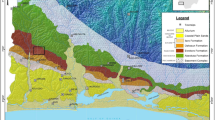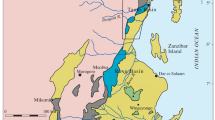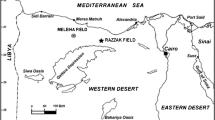Abstract
A palynological analysis was carried out for the first time on sediments from Hupo Basin, East Sea, offshore Korea, to locate the Pliocene–Pleistocene boundary and thus determine the depositional age of this stratigraphic unit. Core 19ESDP-101, taken from Hupo Basin, yielded diverse, abundant to common pollen and dinocysts. Age-diagnostic palynomorphs were present in certain core intervals (Zone I, depths 120–63.96 mbsf). However, those age indicators were dark brown, heavily broken representatives that appeared together with poorly sorted, opaque, dark phytoclasts in the lower part of Zone II (63.96–38.76 mbsf), and they were considered to have been recycled from reworked late Pliocene strata due to contour currents during the transgression. Biostratigraphically meaningful taxa were the pollen Carya, Liquidambar, and Fagus and the dinocysts Filisphaera filifera subsp. pilosa and Spiniferites pachyderma. The latest stratigraphic occurrence of these pollen taxa in northeast Asia is the Late Pliocene, and that of the dinocysts is the Late Pliocene across a wide range of aquatic areas, especially in the Pacific. The last appearance datum of the age indicators in this study suggested 63.96 mbsf (top boundary of Zone I) as the Pliocene–Pleistocene boundary in core 19ESDP-101.










Similar content being viewed by others
References
Batten DJ (1996) Palynofacies and palaeoenvironmental interpretation. In: McGregor DC (ed) Palynology: principles and applications. American Association of Stratigraphic Palynologists Foundation, pp 1011–1064
Bennike O, Abrahamsen N, Bak M et al (2002) A multi-proxy study of Pliocene sediments from Île de France, North-East Greenland. Palaeogeogr Palaeoclimatol Palaeoecol 186:1–23. https://doi.org/10.1016/S0031-0182(02)00439-X
Bong PY (1985) Palynology of the Neogene Strata in the Pohang Sedimentary Basin. Ph.D. Thesis. Seoul National University
Bujak JP (1984) Cenozoic dinoflagellate cysts and acritarchs from the Bering Sea and northern North Pacific, DSDP Leg 19. Micropaleontology 30:180–212
Byun HS (1995) Cenozoic dinoflagellate cysts from the pohang Basin and the southern margin of the Ulleung Basin, Korea. Ph.D. Thesis. Chungnam National University
Chang N-K (1986) Illustrated Flora and Fauna of Korea, vol 29. Kukjeong Gyogwaseo Press, Seoul, Pollen
Chang N-K, Rim YD (1979) Morphological studies on the pollen of flowering plants in Korea. Seoul National University Press, Seoul
Choi DK, Bong PY (1986) Neogene palynomorphs from lignite beds of Bugpyeong and Yeonghae areas, Korea. J Paleontol Soc Korea 2:1–17
Chun JH, Han SJ, Cheong DK et al (1997) Volcanic processes of the Ulleung-II tephra (Ulleung-Oki ash) erupted from the Ulleung Island. Ocean Res 19:275–283
Chung C-H, Koh Y-K (2005) Palynostratigraphic and palaeoclimatic investigations on the Miocene deposits in the Pohang area, South Korea. Rev Palaeobot Palynol 135:1–11. https://doi.org/10.1016/j.revpalbo.2005.02.002
Combaz A (1964) Les palynofaciès. Rev Micropaléontologie 7:205–218
de Schepper S, Head MJ (2009) Pliocene and Pleistocene dinoflagellate cyst and acritarch zonation of DSDP hole 610a, Eastern North Atlantic. Palynology 33:179–218. https://doi.org/10.1080/01916122.2009.9989673
de Castro S, Hernández-Molina FJ, Rodríguez-Tovar FJ et al (2020) Contourites and bottom current reworked sands: Bed facies model and implications. Mar Geol 428:106267. https://doi.org/10.1016/j.margeo.2020.106267
de Weger W, Hernández-Molina FJ, Miguez-Salas O et al (2021) Contourite depositional system after the exit of a strait: Case study from the late Miocene South Rifian Corridor, Morocco. Sedimentology 68:2996–3032. https://doi.org/10.1111/sed.12882
Eshet Y, Druckman Y, Cousminer HL et al (1988) Reworked palynomorphs and their use in the determination of sedimentary cycles. Geology 16:662. https://doi.org/10.1130/0091-7613(1988)016%3c0662:RPATUI%3e2.3.CO;2
Grimm E (2011) Tilia 1.7.16 Software. Illinois State Museum, Research and Collection Center, Springfield, II
Haq BU, Hardenbol J, Vail PR (1987) Chronology of fluctuating sea levels since the triassic. Science 235:1156–1167. https://doi.org/10.1126/science.235.4793.1156
Hayashi R, Sagawa T, Irino T, Tada R (2021) Orbital-scale vegetation-ocean-atmosphere linkages in western Japan during the last 550 ka based on a pollen record from the IODP site U1427 in the Japan Sea. Quat Sci Rev 267:107103. https://doi.org/10.1016/j.quascirev.2021.107103
Head MJ (1994) Morphology and paleoenvironmental significance of the cenozoic dinoflagellate genera tectatodinium and habibacysta. Micropaleontology 40:289. https://doi.org/10.2307/1485937
Head MJ (1996) Late Cenozoic dinoflagellates from the royal society borehole at Ludham, Norfolk, Eastern England. J Paleontol 70:543–570. https://doi.org/10.1017/S0022336000023532
Head MJ, Edwards LE, Garrett JK et al (1993) A forum on Neogene and quaternary dinoflagellate cysts: the edited transcript of a round table discussion held at the third workshop on Neogene and Quaternary dinoflagellates; with taxonomic appendix. Palynology 17:201–239. https://doi.org/10.1080/01916122.1993.9989428
Head MJ, Riding JB, Eidvin T, Chadwick RA (2004) Palynological and foraminiferal biostratigraphy of (Upper Pliocene) Nordland Group mudstones at Sleipner, northern North Sea. Mar Pet Geol 21:277–297. https://doi.org/10.1016/j.marpetgeo.2003.12.002
Hennissen JAI, Head MJ, De Schepper S, Groeneveld J (2017) Dinoflagellate cyst paleoecology during the Pliocene-Pleistocene climatic transition in the North Atlantic. Palaeogeogr Palaeoclimatol Palaeoecol 470:81–108. https://doi.org/10.1016/j.palaeo.2016.12.023
Heusser LE (1992) Preliminary Results of High-Resolution Pollen Analyses of Selected Pleistocene Intervals from Holes 798A, 798B, and 798C. In: Proceedings of the Ocean Drilling Program, 127/128 Scientific Results. Ocean Drilling Program, pp 317–324
Hong SW, Yoo DG, Lee GS, Kim JC, Yi S, Kim GY, Bahk JJ, Yu S (2022) Late Pliocene to Quaternary sedimentary facies and stratigraphy of shallow-water contourite deposits in the Hupo Basin, East Sea of Korea. Mar Geo Res
KIGAM (2021) Study on submarine active faults and evaluation of possibility of submarine earthquakes in the southern part of the East Sea, Korea. Report of Korea Institute of Geoscience and Mineral Resources (20190016), Daejeon
Kim BK (1970) A study on the Neogene Tertiary deposits in Korea. J Geol Soc Korea Soc Korea 6:77–96
Kim Y, Yi S, Kim G, Lee E (2017) Late Miocene paleoceanography of the Eastern South Korea Plateau, East Sea, inferred from the palynofacies and dinoflagellates of U1430 core, IODP Exp. 346. J Geol Soc Korea 53:645–656. https://doi.org/10.14770/jgsk.2017.53.5.645
Kim Y, Yi S, Kim G-Y et al (2019) Palynological study of paleoclimate and paleoceanographic changes in the Eastern South Korea Plateau, East Sea, during the Plio-Pleistocene climate transition. Palaeogeogr Palaeoclimatol Palaeoecol 520:18–29. https://doi.org/10.1016/j.palaeo.2019.01.021
Lee JH, Cho HJ, Hur TC (2006) Spatial distribution and vegetation-environment relationship of forest vegetation in Ulleung Island, Korea. J Ecol F Biol 29:521–529. https://doi.org/10.5141/JEFB.2006.29.6.521
Liu G, Leopold EB, Liu Y et al (2002) Palynological record of Pliocene climate events in North China. Rev Palaeobot Palynol 119:335–340. https://doi.org/10.1016/S0034-6667(01)00125-7
Liu H, Xing Q, Ji Z et al (2003) An outline of Quaternary development of Fagus forest in China: palynological and ecological perspectives. Flora—Morphol Distrib Funct Ecol Plants 198:249–259. https://doi.org/10.1078/0367-2530-00098
Maher LJ (1981) Statistics for microfossil concentration measurements employing samples spiked with marker grains. Rev Palaeobot Palynol 32:153–191. https://doi.org/10.1016/0034-6667(81)90002-6
Marret F, Zonneveld KAF (2003) Atlas of modern organic-walled dinoflagellate cyst distribution. Rev Palaeobot Palynol 125:1–200. https://doi.org/10.1016/S0034-6667(02)00229-4
Matsuoka K (1983) Late Cenozoic dinoflagellates and Acritarchs in the Niigata District, Central Japan. Palaeontogr Abteilung B 187:89–154
Matsuoka K, Bujak JP, Shimazaki T (1987) Late Cenozoic dinoflagellate cyst biostratigraphy from the west coast of northern Japan. Micropaleontology 33:214–229
Matsuoka K, Bujak JP (1988) Cenozoic dinoflagellate cysts from the Navarin Basin, Norton Sound and St. George Basin, Bering Sea. Bulletin of Faculty of Liberal Arts, Nagasak University (Natural Science), Nagasaki
Matthiessen J, Brenner W (1996) Dinoflagellate Cyst Ecostratigraphy of Pliocene–Pleistocene Sediments from the Yermak Plateau (Arctic Ocean, Hole 911A). In: Proceedings of the Ocean Drilling Program, 151 Scientific Results. Ocean Drilling Program
McCarthy F, Findlay D, Little M (2004) The micropaleontological character of anomalous calcareous sediments of late Pliocene through early Pleistocene age below the CCD in the northwestern North Pacific Ocean. Palaeogeogr Palaeoclimatol Palaeoecol 215:1–15. https://doi.org/10.1016/S0031-0182(04)00402-X
McMinn A (1992) Pliocene through Holocene dinoflagellate cyst biostratigraphy of the Gippsland Basin, Australia. In: Head MJ, Wrenn JH (eds) Neogene and quaternary dinoflagellate cysts and acritarchs. America Association of Stratigraphic Palynologists Foundation, Texas, pp 147–161
Miller KG, Kominz MA, Browning JV et al (2005) The phanerozoic record of global sea-level change. Science 310:1293–1298. https://doi.org/10.1126/science.1116412
Miyoshi N, Fujiki T, Morita Y (1999) Palynology of a 250-m core from Lake Biwa: a 430,000-year record of glacial–interglacial vegetation change in Japan. Rev Palaeobot Palynol 104:267–283. https://doi.org/10.1016/S0034-6667(98)00058-X
Moore PD, Webb JA, Collison ME (1991) Pollen analysis, 2nd edn. Blackwell Scientific Publications, Oxford
Mudie PJ (1989) Palynology and Dinocyst Biostratigraphy of the Late Miocene to Pleistocene, Norwegian Sea: ODP Leg 104, Sites 642 to 644. In: Proceedings of the Ocean Drilling Program, 104 Scientific Results. Ocean Drilling Program, pp 587–610
Nakamura J (1980) Diagnostic characters of pollen grains of Japan Part II. Spec Publicait Osaka Museum, Nat Hist 12:1–92
Park JB (1995) Paleopalynology of the Changgi Group (Tertiary), Keumgwangdong and Youngam Areas, Korea. Ph.D. Thesis. Seoul National University
Park Y, Kang N, Yi B et al (2021) Tectonostratigraphic framework in the eastern Korean continental margin, East Sea: implication for evolution of the Hupo Basin. Basin Res. https://doi.org/10.1111/bre.12641
PEDCO (1995) Micropaleontology, petroleum geochemistry and petrology of Gorae 1–1, offshore Korea Block VI-1. Report of Korea Institute of Geoscience and Mineral Resources
Powell AJ (1992) A stratigraphic index of dinoflagellate cysts. British Micropaleontological Society Publication Series, Chapman & Hall, London
Ramírez-Valencia V, Paez-Reyes M, Salgado J et al (2021) Distribution of organic-walled dinoflagellate cysts in surface sediments of the southern Caribbean and the eastern tropical Pacific and its environmental implications. Mar Micropaleontol 167:102000. https://doi.org/10.1016/j.marmicro.2021.102000
Rebesco M, Hernández-Molina FJ, Van Rooij D, Wåhlin A (2014) Contourites and associated sediments controlled by deep-water circulation processes: state-of-the-art and future considerations. Mar Geol 352:111–154. https://doi.org/10.1016/j.margeo.2014.03.011
Sebag D, Copard Y, Di-Giovanni C et al (2006) Palynofacies as useful tool to study origins and transfers of particulate organic matter in recent terrestrial environments: synopsis and prospects. Earth-Science Rev 79:241–259. https://doi.org/10.1016/j.earscirev.2006.07.005
Song ZC, Guan XT, Li ZR et al (1985) A study of Cenozoic palynology of the Longjing structural area in the Shelf Basin of the East China Sea region. Anhui Science and Technology Publishing House
Starling RN, Crowder A (1980) Pollen in the salmon river system, Ontario, Canada. Rev Palaeobot Palynol 31:311–334. https://doi.org/10.1016/0034-6667(80)90033-0
Stockmarr J (1971) Tablets with spores used in absolute pollen analysis. Pollen Spores 13:615–621
Tai A (1966) Pollen analysis of the core (OD-1) in Osaka City—research on younger Cenozoic strata in Kinki Province, Part V. Geol Sci 83:25–29
Traverse A (1988) Paleopalynology. Unwin Hyman, Boston
Tyson RV (1995) Sedimentary organic matter. Springer, Netherlands, Dordrecht
Vernal de A, Mudie PJ (1989) Pliocene and Pleistocene Palynostratigraphy at ODP Sites 646 and 647, Eastern and Southern Labrador Sea. In: Proceedings of the Ocean Drilling Program, 105 Scientific Results. Ocean Drilling Program, pp 401–422
Wessel P, Luis JF, Uieda L et al (2019) The generic mapping tools version 6. Geochem, Geophys Geosystems 20:5556–5564. https://doi.org/10.1029/2019GC008515
Williams GL, Brinkhuis H, Pearce MA, et al (2004) Southern Ocean and Global Dinoflagellate Cyst Events Compared: Index Events for the Late Cretaceous–Neogene. In: Proceedings of the Ocean Drilling Program, 189 Scientific Results. Ocean Drilling Program
Yamanoi T (1978) Neogene pollen stratigraphy of the Oga Peninsula, Northeast Honshu, Japan. J Geol Soc Japan 84:69-86_1. https://doi.org/10.5575/geosoc.84.69
Yamanoi T (1989) Neogene palynological zones and events in Japan. In: Proceedings of International Symposium on Pacific Neogene Continent and Marine Events. Nanjing University Press, Nangjing, pp 81–90
Yamanoi T (1992) Miocene Pollen Stratigraphy of Leg 127 in the Japan Sea and Comparison with the Standard Neogene Pollen Floras of Northeast Japan. In: Proceedings of the Ocean Drilling Program, 127/128 Scientific Results, Proceeding. Ocean Drilling Program, pp 130–132
Yi S, Yi S, Batten DJ et al (2003) Cretaceous and Cenozoic non-marine deposits of the Northern South Yellow Sea Basin, offshore western Korea: palynostratigraphy and palaeoenvironments. Palaeogeogr Palaeoclimatol Palaeoecol 191:15–44. https://doi.org/10.1016/S0031-0182(02)00637-5
Yi S, Bahk J-J, Jia H, Yoo D-G (2012) Pliocene-Pleistocene boundary determination in hemipelagic sediment from the Ulleung Basin (East Sea, offshore Korea) inferred from terrigenous and marine palynofloras. Rev Palaeobot Palynol 181:54–63. https://doi.org/10.1016/j.revpalbo.2012.05.002
Yi S, Bong P-Y, Lee M-S (2004) Pollen and spores of South Korea. J Paleontol Soc Korea Spec Pulication 431–458
Yoon SH, Sohn YK, Chough SK (2014) Tectonic, sedimentary, and volcanic evolution of a back-arc basin in the East Sea (Sea of Japan). Mar Geol 352:70–88. https://doi.org/10.1016/j.margeo.2014.03.004
Acknowledgements
This research was supported by the “Study on submarine active faults and evaluation of possible submarine earthquakes in the southern part of the East Sea, Korea (NP2018-018)” of the KIGAM, funded by the Ministry of Ocean and Fisheries of Korea, and also in part by basic research grants (GP2020-003) from the KIGAM, funded by the Ministry of Science and ICT of Korea. This paper was prepared for the special issue entitled “Geological implications for submarine geohazards, Ulleung Basin, East Sea”. We sincerely thank Dr. Jaume Llopart, Guest Editor, and the anonymous reviewers for their constructive comments that improved the manuscript.
Author information
Authors and Affiliations
Corresponding author
Ethics declarations
Conflict of interest
The authors declare that they have no known competing financial interests or personal relationships that could have appeared to influence the work reported in this paper.
Additional information
Publisher's Note
Springer Nature remains neutral with regard to jurisdictional claims in published maps and institutional affiliations.
Rights and permissions
About this article
Cite this article
Yi, S., Hong, SW., Yoo, DG. et al. Palynostratigraphy indication of the Pliocene–Pleistocene boundary in Hupo Basin of the East Sea, offshore Korea. Mar Geophys Res 43, 28 (2022). https://doi.org/10.1007/s11001-022-09490-0
Received:
Accepted:
Published:
DOI: https://doi.org/10.1007/s11001-022-09490-0




